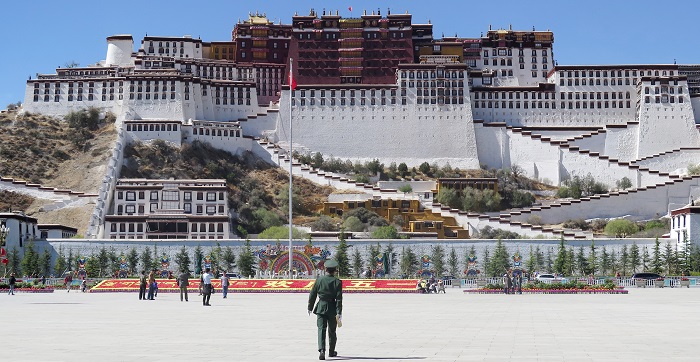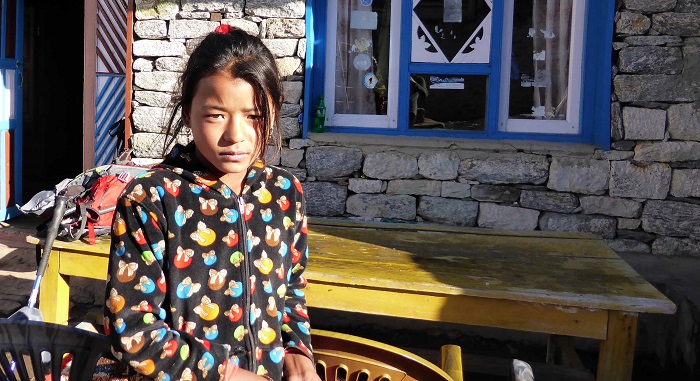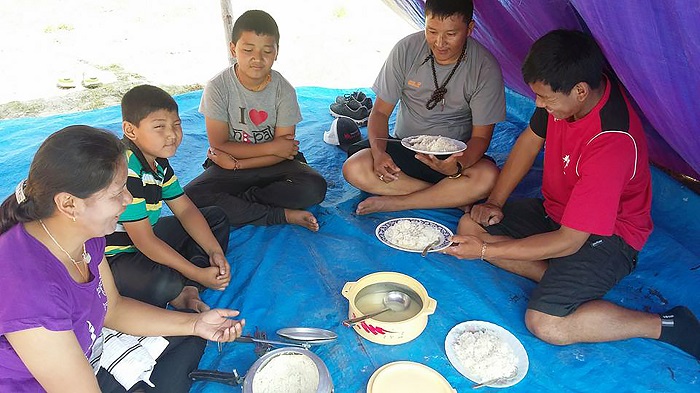This is part three following my climb to the summit of the highest mountain in the world, Mount Everest.
Part one was written a month ago before I left from Dubai and in part two we spent many weeks acclimatizing, getting to base camp and establishing higher camps on the mountain. This final part should have been about the final days preparing to climb over 8000m and the freedom of climbing a beautiful ridge to the summit looking one way into the beautiful country of Nepal and the other way into Tibet. Instead I am now back in Dubai.
Everything changed on the 25th April. Not just for me but the people of Nepal. By now, we all know about the devastating earthquake and the long term damage that it has caused to Nepal and its people. We had been away from Dubai for just over four weeks when the first waves struck. We could feel them moving underneath us. Lucky for us we were at base camp on the north side and our tents were in the middle of a flat area so rocks that were shaken free and simply tumbled to the side. The pictures and reports that appeared instantly on social media showed just how lucky the north was. No one lost their life on the north. We were shaken, literally and continued to be for the next two weeks. It took us that long to be evacuated to Lhasa and then fly home. That period was a time of huge uncertainty for everyone. The aftershocks became a regular feature of our lives. We remained at base camp waiting for the CTMA (Chinese Tibetan Mountaineering Association) to transport us to safety. Normally we would have driven back through Kodari to Kathmandu but the road was so devastated that we had to go north to escape. The narrow and winding pass that cuts through the Himalaya will take months if not years to reopen.

As I write this it should be coming up to summit day. This will be the first time since 1974 that no one has summited Everest. Each year the weather window that allows people to climb high is around 20th May so a lot of the 60 days on expedition is spent waiting and watching. At all other times of the year it is just too cold and too windy because of the jet stream.
The Jet Stream
Jet streams are fast flowing, narrow air currents found in the Earth’s atmosphere. Jet streams are caused by a combination of the planet’s rotation on its axis and atmospheric heating. The jet stream sits on top of Everest almost all year long and when it does the winds at the summit can blow at over 300kmh and lower temperatures to -60 degrees Celsius. In mid-May each year, the jet stream moves north causing the winds to drop and temperatures to become warm enough for people to try to summit. This is called the “summit window”. There is a similar period each fall in November but it is less predictable.
At the start of this week there was another 7.4 quake on the 12th of May. Even though I wasn’t in Nepal this time, I felt like I was. Social media instantly came alive with reports of an epicentre around Jhiri – a new one and not an aftershock. It had been predicted like many of the 300 aftershocks I had been through. My friends who were still in Nepal reported that this one appeared more violent than the first one; luckily it was deeper and the damage to the infrastructure of Nepal was apparently less or maybe it was just now old news.

All of our Sherpas had just returned to Kathmandu to be reunited with their families. It had taken them over two weeks to get home. They are brave people but even they are scared. They don’t ask for help often but now the messages I get are heartbreaking. Sherpas I have worked with over the years are venting their anguish and frustration on Facebook, questioning why it was happening to them and their families again. The young son of a Sherpa who I have never met uses his dad’s account to message me: “Lakpa Dendi Sherpa climber house has been destroyed today in Nepal 12:50 pm by earthquake. So he is still in here all his small children and wife are feeling sad. I hope if you can help to him whatever you can. We are still in very unsafe situation. Because our village are totally undevelopment country. As we hear in Kathmandu there is still no government help”. I felt helpless. Back home in Dubai I did not feel the waves through the ground and the rocks shaking themselves loose from the mountains as before but the sense of sadness and desperation is all too real.
What can we do for them? The monsoon is approaching and their complete families are living in tents because their whole houses are lost; others because their houses are too unstable. Aftershocks are still happening regularly every day and people are scared. I still have friends there who are helping with the relief effort.
Another friend, Jangbu Sherpa was featured in the May issue. He’s climbed Everest many times and now he is living with his family in a tent in Kathmandu. With the trekking and climbing season effectively finished, tourists have left Nepal. There are some but nowhere near the numbers that is expected at this time of the year. I flew back to Kathmandu and spent a day in the capital. It had a deserted feeling. The streets were empty and the world press has left. Certain districts have suffered more damage than others and only now is the true extent of the damage in the countryside being discovered as aid agencies are able to get to people. The terrain and lack of roads makes any movement without a helicopter very difficult.

One of the areas that suffered was the Langtang Valley. Only three weeks before we had trekked through on our acclimatization stage, spending seven days in the region, we had made many friends of the café and lodge owners. On 25th of April the entire Langtang Village was buried under a landslide. Over 200 inhabitants and westerners staying there were lost in a matter of minutes. The pictures show the total destruction of such a beautiful area.
Back in Dubai everybody wants to help but the situation is very confusing. Where should money be directed and to whom? What is happening with the aid that is there already? Who do we help first? What do we give? Can we collect money? Although my adventure started as a quest to climb Everest this has really turned into something very different.
A huge thank you to all the individuals, companies and organizations that have supported me, we hope you are following and it inspires you to keep doing what you are doing. Keep checking the OutdoorUAE and OutdoorArabia media channels for more immediate updates.
We would like to thank the following sponsors for their interest and support in what we do and in particular Everest 2015.GO Sport and the Millet brand as well as Nite Watches and Al Mekshah have provided the best equipment and support possible as well as numerous others.
If you are interested in visiting Nepal and getting involved in the rebuilding, they desperately need tourists to start going back now more than ever. Although tourism is only 10% of the economy it goes directly to the tea houses, guides, porters and locals. The hard, foreign currency is vital to let them start again and begin providing for themselves. We can guide you from start to finish in whatever your goal is. Contact us or join us to find your own adventure around the world.
Words By: Sean James

